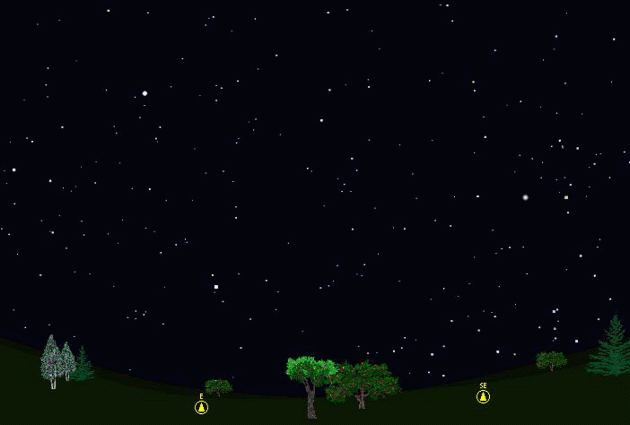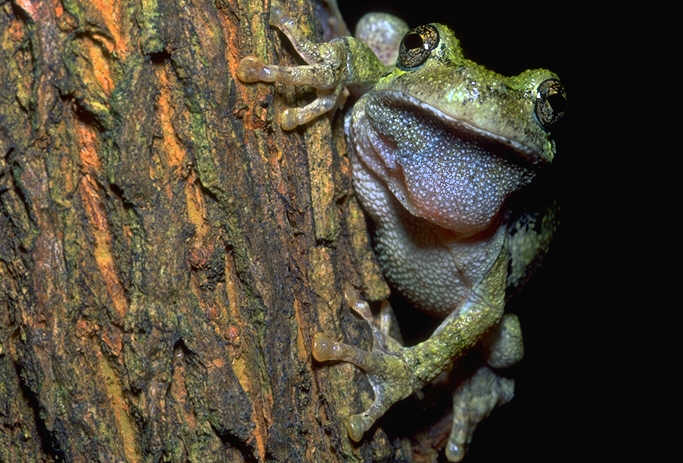The purpose of this feature is to give scout leaders, educators and naturalists an idea of some of the natural events coming up each month. We will try to cover a variety of natural events ranging from sky events to calling periods of amphibians, bird and mammal watching tips, prominent wildflowers and anything else that comes to mind. We will also note prominent constellations appearing over the eastern horizon at mid-evening each month for our area for those who would like to learn the constellations. If you have suggestions for other types of natural information you would like to see added to this calendar, let us know!. Note: You can click on the hyperlinks to learn more about some of the featured items. To return to the Calendar, hit the "back" button on your browser, NOT the "back" button on the web page. All charts are available in a "printer friendly" mode, with black stars on a white background. Left clicking on each chart will take you to a printable black and white image.
Notes and Images From May 2007
I photographed this jumping spider foraging along the forest floor. About 300 species of jumping spiders occur in North America. This species is probably in the genus Phidippus. These small spiders are said to have among the best vision of the invertebrates, and they can jump many times their own length to capture prey. One captive Phidippus was observed to eat more than 40 fruit flies in succession. They are extremely alert, and if you attempt to photograph one don't be surprised if it hops onto your camera lens!
Sky Events for June 2007: The summer solstice, marking the official beginning of summer, occurs at 1:06pm CDT on June 21st. Evening Sky: Mercury is low in the western sky as June begins. Look for it starting about 40 minutes after sundown between Venus and the sunset point, about 10 degrees above the horizon. It will rapidly fade from view as the month progresses. Venus reaches greatest elongation east of the sun on June 8th, and will shine brilliantly in the western sky after sunset. It will continue to brighten till mid-July. If you plan a telescopic view, be sure to look at it as soon as it becomes visible - if you wait until the sky darkens your view will not be as good. Saturn is above and to the left of Venus as you face west, in the constellation of Leo. As the month progresses, watch for the two planets to approach each other until, on June 30th, they are less than one degree apart. By mid-month Jupiter is about 22 degrees above the eastern horizon at 9:30pm in Ophiuchus, and is the brightest star-like object in the eastern sky. You can use Jupiter to guide you to a possible naked-eye sighting of the minor planet Vesta in early June. Vesta is the brightest asteroid, and it reached opposition (and maximum brightness) on May 30th. At magnitude 5.4, you may want to see if you can pick it out with your naked eye. A finder chart can be found at the Sky and Telescope website at: http://www.skyandtelescope.com/observing/highlights/7297386.html
Morning Sky: Mars rises about 2:15am at midmonth in Pisces. All times noted in the Sky Events are for Franklin, Tennessee and are Central Daylight Time. These times should be pretty close anywhere in the mid-state area. Constellations: The views below show the sky looking east at 9:50pm CDT on June 15th. The first view shows the sky with the constellation outlined and names depicted. Star and planet names are in yellow. Constellation names are in green. The second view shows the same scene without labels. New constellations this month in the eastern sky are Cygnus, the Swan, with its bright star Deneb, and Aquila, the Eagle, with its bright star Altair. The bright stars Deneb, Altair and Vega form the "Summer Triangle." If you locate them first, you will have an easier time finding the constellations around them. Below and to the left of Altair is the constellation of Delphinus, the Dolphin, looking like it's leaping over the eastern horizon. Above Delphinus look for the arrow-like form of Sagitta, the Arrow. Between Sagitta and Cygnus lie the faint stars of Vulpecula, the Fox. Easier to spot are the brightest stars of Sagittarius, the Archer, which form a grouping nicknamed, "The Teapot." Look for them just above the southeast horizon. "The Teapot" will become easier to see as it rises higher above the horizon. On very clear summer nights the bright portions of the Milky Way above Sagittarius look like steam rising from the spout of the teapot. If you look just to the right of the spout of the teapot, you will be looking in the direction of the center of our galaxy. The little grouping of stars to the left of Sagittarius is nicknamed, "The Teaspoon." All of the constellation Scorpius, the Scorpion, with its bright star Antares, should now be above the horizon in the southeast. The planet Jupiter shines brightly nearby. Also in the southeast and above Sagittarius, look for the faint stars of Scutum.
On Learning the Constellations: We advise learning a few constellations each month, and then following them through the seasons. Once you associate a particular constellation coming over the eastern horizon at a certain time of year, you may start thinking about it like an old friend, looking forward to its arrival each season. The stars in the evening scene above, for instance, will always be in the same place relative to the horizon at the same time and date each June. Of course, the planets do move slowly through the constellations, but with practice you will learn to identify them from their appearance. In particular, learn the brightest stars (like Altair and Vega in the above scene looking east), for they will guide you to the fainter stars. Once you can locate the more prominent constellations, you can "branch out" to other constellations around them. It may take you a little while to get a sense of scale, to translate what you see on the computer screen or what you see on the page of a book to what you see in the sky. Look for patterns, like the stars that make up the constellation Lyra. The earth's rotation causes the constellations to appear to move across the sky just as the sun and the moon appear to do. If you go outside earlier than the time shown on the charts, the constellations will be lower to the eastern horizon. If you observe later, they will have climbed higher. As each season progresses, the earth's motion around the sun causes the constellations to appear a little farther towards the west each night for any given time of night. If you want to see where the constellations in the above figures will be on July 15th at 9:50pm CDT, you can stay up till 11:50pm CDT on June 15th and get a preview. The westward motion of the constellations is equivalent to two hours per month. A good book to learn the constellations is H. A. Rey's classic, The Stars, A New Way to See Them. Rey's depictions of the constellations and witty commentary are terrific. A good general reference book on astronomy is the Peterson Field Guide, A Field Guide to the Stars and Planets, by Pasachoff. The book retails for around $14.00. My favorite books about astronomers are Richard Preston's First Light, and the wonderful Starlight Nights, by Leslie Peltier. A good beginners software program for learning the night sky is the Starry Night Beginner program. Visit the Starry Night web site at www.starrynight.com The program retails for around $30.00 and contains a wealth of information.
Amphibians:
In June the treefrogs really hit their stride. Listen for Cope's Gray Treefrogs, Gray Treefrogs, Bird-Voiced Treefrogs, Green Treefrogs and Barking Treefrogs. Northern Cricket Frogs and Southern Cricket Frogs call a lot during June, and the calls of Bullfrogs and Green Frogs fill the night air. After heavy rains listen for the high, insect-like call of the Eastern Narrowmouth Toad and the strange-sounding Eastern Spadefoot.
Birds: Now is a good time to get to know the breeding birds of Tennessee. It's fun to take a trip to the Great Smoky Mountains National Park in June and hike a high altitude trail, like the Alum Cave Bluff trail. By doing so you can encounter birds that breed in Tennessee at these higher elevations, like Black-throated Blue Warblers, Canada Warblers, Chestnut-sided Warblers and Blackburnian Warblers. Recommended: Bird Finding in Tennessee, Michael Lee Bierly. A classic guide to finding birds in Tennessee. The Sibley Guide to Birds, David Allen Sibley The Sibley Guide to Birds of Eastern North America, David Allen Sibley This new Sibley Guide covers only eastern North America, is quite compact, and is less expensive than the larger Sibley. An inexpensive guide for beginners is the Golden Guide for Birds.
Archives (Remember to use the back button on your browser, NOT the back button on the web page!) Natural Calendar February 2007 Natural Calendar December 2006 Natural Calendar November 2006 Natural Calendar September 2006 Natural Calendar February 2006
Natural Calendar
December 2005
Natural Calendar
November 2005
Natural Calendar
September 2005
Natural Calendar
February 2005
Natural Calendar
December 2004
Natural Calendar
November 2004
Natural Calendar
September 2004
Natural Calendar
February 2004
Natural Calendar
December 2003
Natural Calendar
November 2003
Natural Calendar
September 2003 Natural Calendar February 2003 Natural Calendar December 2002 Natural Calendar November 2002 Nature Notes Archives: Nature Notes was a page we published in 2001 and 2002 containing our observations about everything from the northern lights display of November 2001 to frog and salamander egg masses. Night scenes prepared with Starry Night Pro software All images and recordings © 2007 Leaps
|



